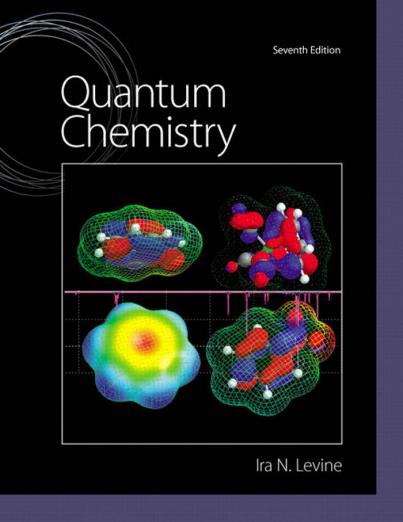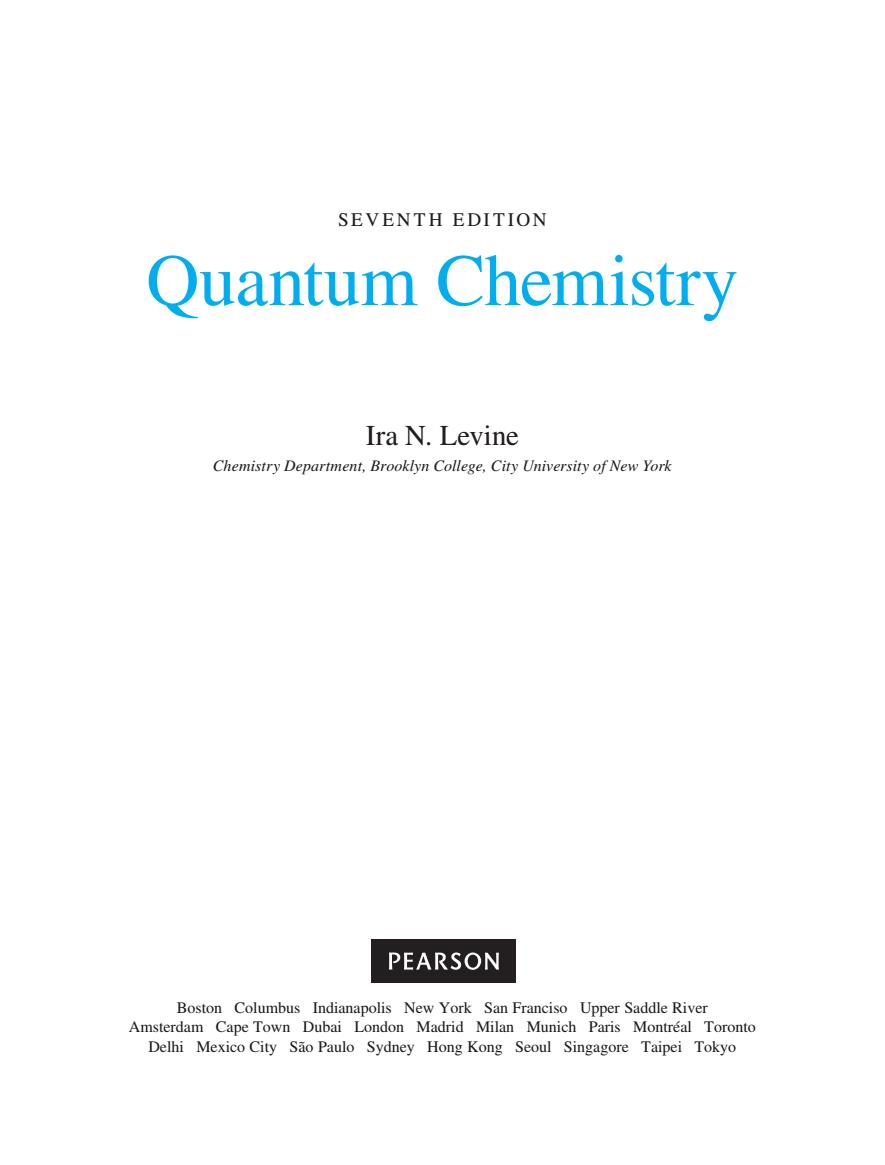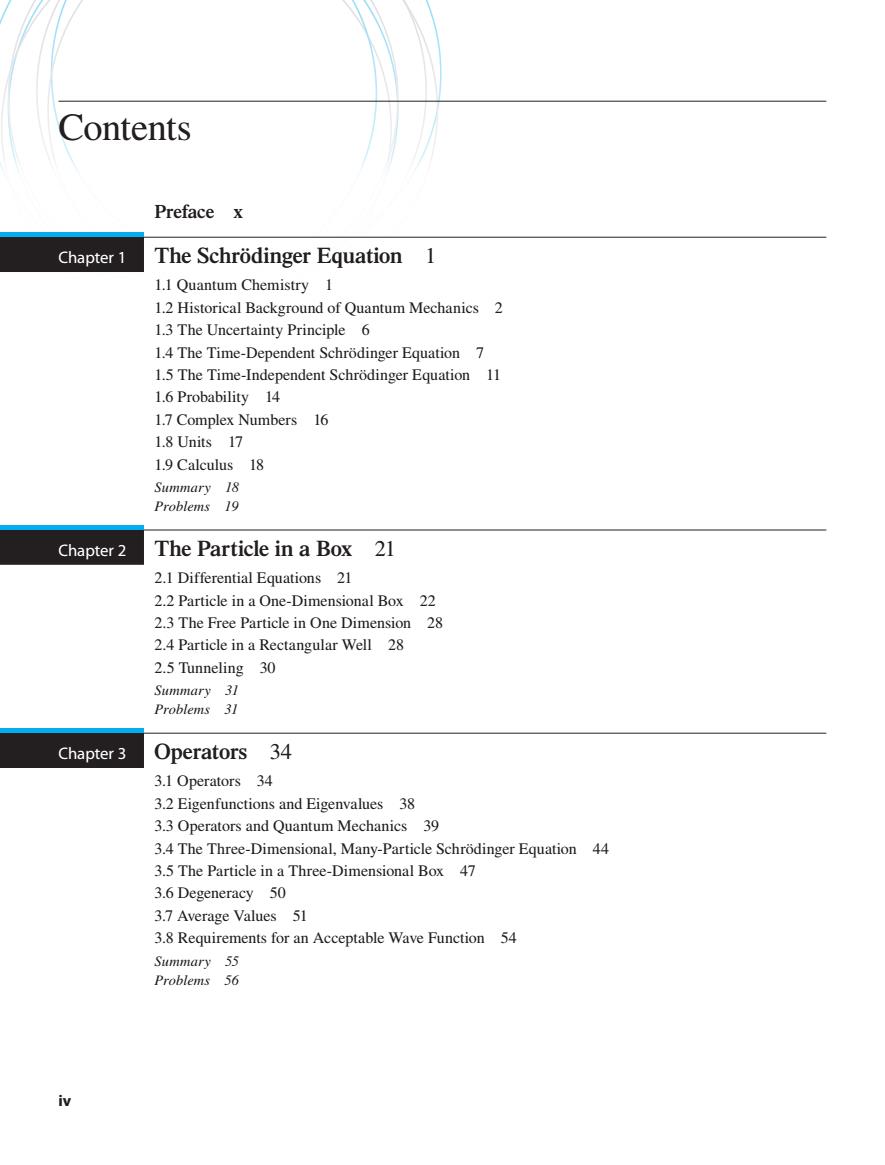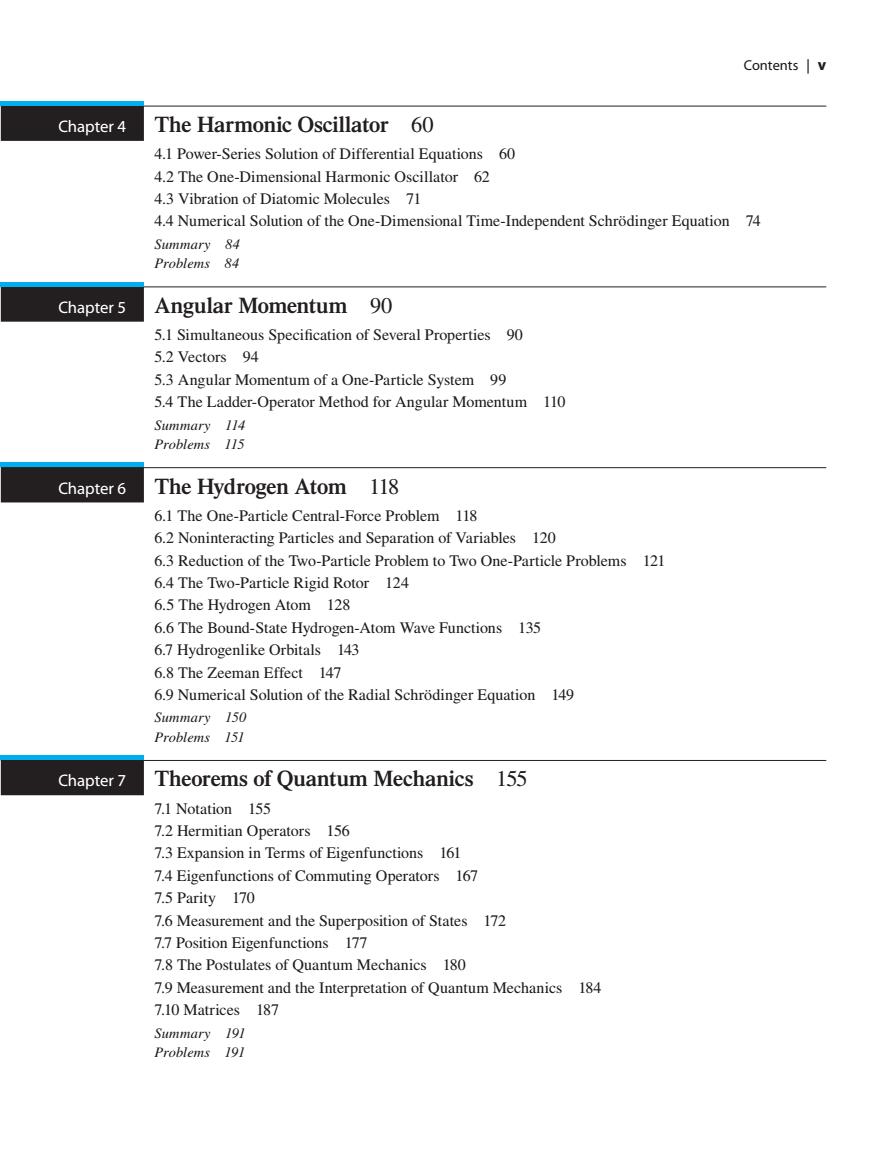
Seventh Edition Quantum Chemistry Ira N.Levine

SEVENTH EDITION Ouantum Chemistry Ira N.Levine Chemistry Department.Brooklyn College,City University of New York PEARSON Boston Columbus Indianapolis New York San Franciso Upper Saddle River Amsterdam Cape Town Dubai London Madrid Milan Munich Paris Montreal Toronto Delhi Mexico City Sao Paulo Sydney Hong Kong Seoul Singagore Taipei Tokyo
Quantum Chemistry Boston Columbus Indianapolis New York San Franciso Upper Saddle River Amsterdam Cape Town Dubai London Madrid Milan Munich Paris Montréal Toronto Delhi Mexico City São Paulo Sydney Hong Kong Seoul Singagore Taipei Tokyo Se v e nth Edition Ira N. Levine Chemistry Department, Brooklyn College, City University of New York

Contents Preface x Chapter 1 The Schrodinger Equation 1 1.1 Quantum Chemistry 1 1.2 Historical Background of Quantum Mechanics 2 1.3 The Uncertainty Principle 6 1.4 The Time-Dependent Schrodinger Equation 7 1.5 The Time-Independent Schrodinger Equation 11 1.6 Probability 14 1.7 Complex Numbers 16 1.8 Units 17 19 Calculus 18 Chapter2 The Particle in a Box 21 2.1 Differential Equations 21 2.2 Particle in a One-Dimensional Box 22 2.3 The Free Particle in One Dimension 28 2.4 Particle in a Rectangular Well 28 2.5 Tunneling 30 Summary 31 Problems 31 Chapter3 Operators 34 3.1 Operators 34 3.2Eigenfunctions and Eigenvalues 38 3.3Operators and Quantum Mechanics 39 3.4 The Three-Dimensional,Many-Particle Schrodinger Equation 44 3.5 The Particle in a Three-Dimensional Box 47 3.6 Degeneracy 50 3.7 Average Values 51 3.8 Requirements for an Acceptable Wave Function 54 55 iv
iv Preface x Chapter 1 The Schrödinger Equation 1 1.1 Quantum Chemistry 1 1.2 Historical Background of Quantum Mechanics 2 1.3 The Uncertainty Principle 6 1.4 The Time-Dependent Schrödinger Equation 7 1.5 The Time-Independent Schrödinger Equation 11 1.6 Probability 14 1.7 Complex Numbers 16 1.8 Units 17 1.9 Calculus 18 Summary 18 Problems 19 Chapter 2 The Particle in a Box 21 2.1 Differential Equations 21 2.2 Particle in a One-Dimensional Box 22 2.3 The Free Particle in One Dimension 28 2.4 Particle in a Rectangular Well 28 2.5 Tunneling 30 Summary 31 Problems 31 Chapter 3 Operators 34 3.1 Operators 34 3.2 Eigenfunctions and Eigenvalues 38 3.3 Operators and Quantum Mechanics 39 3.4 The Three-Dimensional, Many-Particle Schrödinger Equation 44 3.5 The Particle in a Three-Dimensional Box 47 3.6 Degeneracy 50 3.7 Average Values 51 3.8 Requirements for an Acceptable Wave Function 54 Summary 55 Problems 56 Contents

Chapter4 The Harmonic Oscillator 60 4.1 Power-Series Solution of Differential Equations60 4.2 The One-Dimensional Harmonic Oscillator 62 4.3 Vibration of Diatomic Molecules 71 4.4 Numerical Solution of the One-Dimensional Time-Independent Schrodinger Equation 74 Chapter5 Angular Momentum 90 5.1 Simultaneous Specification of Several Properties 9 5.2 Vectors 94 5.3 Angular Momentum of a One-Particle System 99 5.4The Ladder-Operator Method for Angular Momentum 110 Chapter6 The Hydrogen Atom 118 6.1 The One-Particle Central-Force Problem 118 6.2 Noninteracting Particles and Separation of Variables 120 6.3 Reduction of the Two-Particle Problem to Two One-Particle Problems 121 6.4 The Two-Particle Rigid Rotor 124 6.5 The Hydrogen Atom 128 6.6 The Bound-State Hydrogen-Atom Wave Functions 135 6.7 Hydrogenlike Orbitals 143 6.8 The Zeeman Effect 147 6.9 Numerical Solution of the Radial Schrodinger Equation 149 Chapter 7 Theorems of Quantum Mechanics 155 7.1 Notation 155 7.2 Hermitian Operators 156 7.3 Expansion in Terms of Eigenfunctions 161 7.4 Eigenfunctions of Commuting Operators 167 7.5 Parity 170 7.6 Measurement and the Superposition of States 172 7.7 Position Eigenfunctions 177 78 The Postulates of Quantum Mechanics 180 7Measurement and the Interpretation of Quantum Mechanics 184 7.10 Matrices 187 Summary 191 Problems 191
Contents | v Chapter 4 The Harmonic Oscillator 60 4.1 Power-Series Solution of Differential Equations 60 4.2 The One-Dimensional Harmonic Oscillator 62 4.3 Vibration of Diatomic Molecules 71 4.4 Numerical Solution of the One-Dimensional Time-Independent Schrödinger Equation 74 Summary 84 Problems 84 Chapter 5 Angular Momentum 90 5.1 Simultaneous Specification of Several Properties 90 5.2 Vectors 94 5.3 Angular Momentum of a One-Particle System 99 5.4 The Ladder-Operator Method for Angular Momentum 110 Summary 114 Problems 115 Chapter 6 The Hydrogen Atom 118 6.1 The One-Particle Central-Force Problem 118 6.2 Noninteracting Particles and Separation of Variables 120 6.3 Reduction of the Two-Particle Problem to Two One-Particle Problems 121 6.4 The Two-Particle Rigid Rotor 124 6.5 The Hydrogen Atom 128 6.6 The Bound-State Hydrogen-Atom Wave Functions 135 6.7 Hydrogenlike Orbitals 143 6.8 The Zeeman Effect 147 6.9 Numerical Solution of the Radial Schrödinger Equation 149 Summary 150 Problems 151 Chapter 7 Theorems of Quantum Mechanics 155 7.1 Notation 155 7.2 Hermitian Operators 156 7.3 Expansion in Terms of Eigenfunctions 161 7.4 Eigenfunctions of Commuting Operators 167 7.5 Parity 170 7.6 Measurement and the Superposition of States 172 7.7 Position Eigenfunctions 177 7.8 The Postulates of Quantum Mechanics 180 7.9 Measurement and the Interpretation of Quantum Mechanics 184 7.10 Matrices 187 Summary 191 Problems 191

viContents Chapter8 The Variation Method 197 8.1 The Variation Theorem 197 8.2 Extension of the Variation Method 201 8.3 Determinants 202 8.4 Simultaneous Linear Equations 205 8.5 Linear Variation Functions 209 8.6 Matrices,Eigenvalues,and Eigenvectors 215 Chapter9 Perturbation Theory 232 9.1 Perturbation Theory 232 9.2 Nondegenerate Perturbation Theory 233 9.3 Perturbation Treatment of the Helium-Atom Ground State 238 9.4 Variation Treatments of the Ground State of Helium 240 9.5 Perturbaion Theory for a Degnerate Energy Leve 245 9.6 Simplification of the Secular Equation 248 9.7 Perturbation Treatment of the First Excited States of Helium 250 98Time-Dependent Perturbation Theory 256 9.9 Interaction of Radiation and Matter 258 Summary 260 Problems 261 chapter1o Electron Spin and the Spin-Statistics Theorem 265 10.1 Electron Spin 265 10.2 Spin and the Hydrogen Atom 268 10.The Spin-Statistics Theorem 268 10.4 The Helium Atom 271 10.5 The Pauli Exclusion Principle 273 10.6 Slater Determinants 277 10.7 Perturbation Treatment of the Lithium Ground State 278 10.8 Variation Treatments of the Lithium Ground State 279 10.9 Spin Magnetic Moment 280 10.10 Ladder Operators for Electron Spin 283 Summary 285 Problems 285 chapter 11 Many-Electron Atoms 289 11.1 The Hartree-Fock Self-Consistent-Field Method 289 11.2 Orbitals and the Periodic Table 295 1.3 Electron Correlation 298 11.4 Addition of Angular Momenta 300
vi | Contents Chapter 8 The Variation Method 197 8.1 The Variation Theorem 197 8.2 Extension of the Variation Method 201 8.3 Determinants 202 8.4 Simultaneous Linear Equations 205 8.5 Linear Variation Functions 209 8.6 Matrices, Eigenvalues, and Eigenvectors 215 Summary 223 Problems 223 Chapter 9 Perturbation Theory 232 9.1 Perturbation Theory 232 9.2 Nondegenerate Perturbation Theory 233 9.3 Perturbation Treatment of the Helium-Atom Ground State 238 9.4 Variation Treatments of the Ground State of Helium 242 9.5 Perturbation Theory for a Degenerate Energy Level 245 9.6 Simplification of the Secular Equation 248 9.7 Perturbation Treatment of the First Excited States of Helium 250 9.8 Time-Dependent Perturbation Theory 256 9.9 Interaction of Radiation and Matter 258 Summary 260 Problems 261 Chapter 10 Electron Spin and the Spin–Statistics Theorem 265 10.1 Electron Spin 265 10.2 Spin and the Hydrogen Atom 268 10.3 The Spin–Statistics Theorem 268 10.4 The Helium Atom 271 10.5 The Pauli Exclusion Principle 273 10.6 Slater Determinants 277 10.7 Perturbation Treatment of the Lithium Ground State 278 10.8 Variation Treatments of the Lithium Ground State 279 10.9 Spin Magnetic Moment 280 10.10 Ladder Operators for Electron Spin 283 Summary 285 Problems 285 Chapter 11 Many-Electron Atoms 289 11.1 The Hartree–Fock Self-Consistent-Field Method 289 11.2 Orbitals and the Periodic Table 295 11.3 Electron Correlation 298 11.4 Addition of Angular Momenta 300